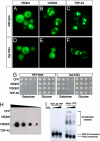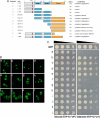A yeast TDP-43 proteinopathy model: Exploring the molecular determinants of TDP-43 aggregation and cellular toxicity
- PMID: 18434538
- PMCID: PMC2359814
- DOI: 10.1073/pnas.0802082105
A yeast TDP-43 proteinopathy model: Exploring the molecular determinants of TDP-43 aggregation and cellular toxicity
Abstract
Protein misfolding is intimately associated with devastating human neurodegenerative diseases, including Alzheimer's, Huntington's, and Parkinson's. Although disparate in their pathophysiology, many of these disorders share a common theme, manifested in the accumulation of insoluble protein aggregates in the brain. Recently, the major disease protein found in the pathological inclusions of two of these diseases, amyotrophic lateral sclerosis (ALS) and frontal temporal lobar degeneration with ubiquitin-positive inclusions (FTLD-U), was identified as the 43-kDa TAR-DNA-binding protein (TDP-43), providing a molecular link between them. TDP-43 is a ubiquitously expressed nuclear protein that undergoes a pathological conversion to an aggregated cytoplasmic localization in affected regions of the nervous system. Whether TDP-43 itself can convey toxicity and whether its abnormal aggregation is a cause or consequence of pathogenesis remain unknown. We report a yeast model to define mechanisms governing TDP-43 subcellular localization and aggregation. Remarkably, this simple model recapitulates several salient features of human TDP-43 proteinopathies, including conversion from nuclear localization to cytoplasmic aggregation. We establish a connection between this aggregation and toxicity. The pathological features of TDP-43 are distinct from those of yeast models of other protein-misfolding diseases, such as polyglutamine. This suggests that the yeast model reveals specific aspects of the underlying biology of the disease protein rather than general cellular stresses associated with accumulating misfolded proteins. This work provides a mechanistic framework for investigating the toxicity of TDP-43 aggregation relevant to human disease and establishes a manipulable, high-throughput model for discovering potential therapeutic strategies.
Conflict of interest statement
Conflict of interest statement: S.L. is a cofounder of and owns stock in FoldRx Pharmaceuticals, a company developing therapies for diseases of protein misfolding. S.L. and A.D.G. are inventors on patents and patent applications that have been licensed to FoldRx Pharmaceuticals.
Figures




Similar articles
-
Quantification of the Relative Contributions of Loss-of-function and Gain-of-function Mechanisms in TAR DNA-binding Protein 43 (TDP-43) Proteinopathies.J Biol Chem. 2016 Sep 9;291(37):19437-48. doi: 10.1074/jbc.M116.737726. Epub 2016 Jul 21. J Biol Chem. 2016. PMID: 27445339 Free PMC article.
-
Expression of TDP-43 C-terminal Fragments in Vitro Recapitulates Pathological Features of TDP-43 Proteinopathies.J Biol Chem. 2009 Mar 27;284(13):8516-24. doi: 10.1074/jbc.M809462200. Epub 2009 Jan 21. J Biol Chem. 2009. PMID: 19164285 Free PMC article.
-
TDP-43 toxicity in yeast.Methods. 2011 Mar;53(3):238-45. doi: 10.1016/j.ymeth.2010.11.006. Epub 2010 Nov 27. Methods. 2011. PMID: 21115123 Free PMC article. Review.
-
Aberrant assembly of RNA recognition motif 1 links to pathogenic conversion of TAR DNA-binding protein of 43 kDa (TDP-43).J Biol Chem. 2013 May 24;288(21):14886-905. doi: 10.1074/jbc.M113.451849. Epub 2013 Apr 4. J Biol Chem. 2013. PMID: 23558684 Free PMC article. Clinical Trial.
-
Cytoplasmic inclusions of TDP-43 in neurodegenerative diseases: a potential role for caspases.Histol Histopathol. 2009 Aug;24(8):1081-6. doi: 10.14670/HH-24.1081. Histol Histopathol. 2009. PMID: 19554515 Free PMC article. Review.
Cited by
-
Dysregulated axonal RNA translation in amyotrophic lateral sclerosis.Wiley Interdiscip Rev RNA. 2016 Sep;7(5):589-603. doi: 10.1002/wrna.1352. Epub 2016 Mar 31. Wiley Interdiscip Rev RNA. 2016. PMID: 27038103 Free PMC article. Review.
-
Mutations in prion-like domains in hnRNPA2B1 and hnRNPA1 cause multisystem proteinopathy and ALS.Nature. 2013 Mar 28;495(7442):467-73. doi: 10.1038/nature11922. Epub 2013 Mar 3. Nature. 2013. PMID: 23455423 Free PMC article.
-
The Toxic Effects of Pathogenic Ataxin-3 Variants in a Yeast Cellular Model.PLoS One. 2015 Jun 8;10(6):e0129727. doi: 10.1371/journal.pone.0129727. eCollection 2015. PLoS One. 2015. PMID: 26052945 Free PMC article.
-
Protein aggregation in amyotrophic lateral sclerosis.Acta Neuropathol. 2013 Jun;125(6):777-94. doi: 10.1007/s00401-013-1125-6. Epub 2013 May 15. Acta Neuropathol. 2013. PMID: 23673820 Free PMC article. Review.
-
PICALM Rescues Endocytic Defects Caused by the Alzheimer's Disease Risk Factor APOE4.Cell Rep. 2020 Oct 6;33(1):108224. doi: 10.1016/j.celrep.2020.108224. Cell Rep. 2020. PMID: 33027662 Free PMC article.
References
-
- Dobson CM. Protein folding and misfolding. Nature. 2003;426:884–890. - PubMed
-
- Forman MS, Trojanowski JQ, Lee VM. Neurodegenerative diseases: A decade of discoveries paves the way for therapeutic breakthroughs. Nat Med. 2004;10:1055–1063. - PubMed
-
- Lee VM, Balin BJ, Otvos L, Jr, Trojanowski JQ. A68: A major subunit of paired helical filaments and derivatized forms of normal Tau. Science. 1991;251:675–678. - PubMed
-
- Glenner GG, Wong CW. Alzheimer's disease: Initial report of the purification and characterization of a novel cerebrovascular amyloid protein. Biochem Biophys Res Commun. 1984;120:885–890. - PubMed
-
- Spillantini MG, et al. Alpha-synuclein in Lewy bodies. Nature. 1997;388:839–840. - PubMed
Publication types
MeSH terms
Substances
Grants and funding
LinkOut - more resources
Full Text Sources
Other Literature Sources
Research Materials
Miscellaneous

